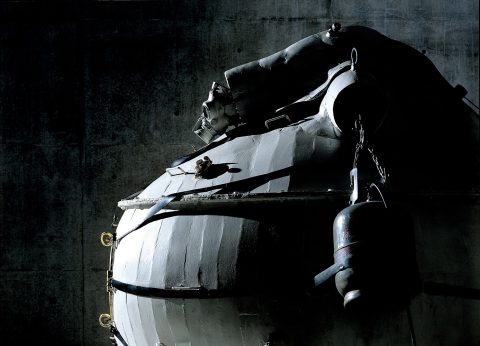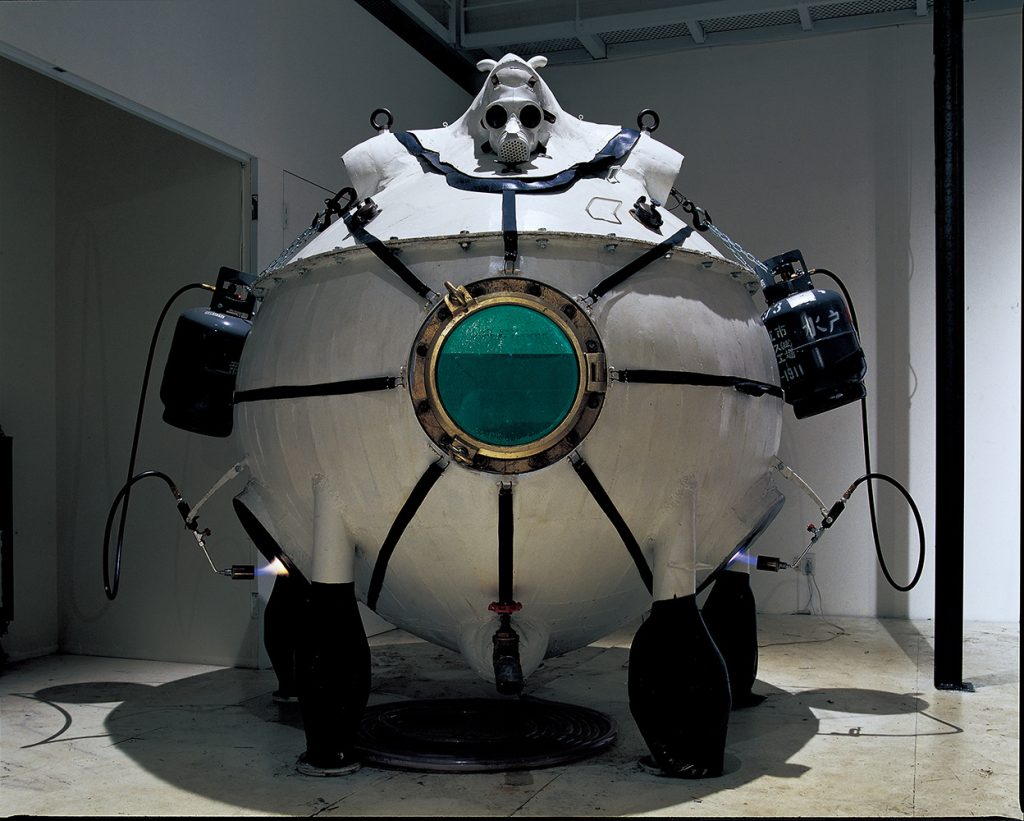
YANOBE KENJI 1969-2005
01 TANKING MACHINE [1969-1997]
【Chapter 01】1969-1997 TANKING MACHINE
Kenji Yanobe was born in Osaka in 1965. As did others of his generation, Yanobe grew up fascinated by the heroic characters of comics and animated films. These included Kamen Rider, Giant Robo, Godzilla, Gamera, and Astro Boy.
Yanobe’s real aspiration, however, was not to become a heroic character, but to become a master of invention who could rescue everyone and make anything. He actually made a full-sized Kamen Rider suit and costume, and wore them himself.
Later, when he went to college, he created more elaborate Gamera costumes and other monsters based on his own artistic awareness. The skills he developed on his own were sufficient to earn him job invitations from professional costume creators, but Yanobe sought his own form of expression. His work, Tanking Machine, brought an end to his university days in 1990. The artist Kenji Yanobe was born.
Yanobe devoted himself to the world of art and released a series of work to create his own distinctive world of delusion
TANKING MACHINE
Just what is art? Kenji Yanobe immersed himself in finding the answer to that question and immersed himself into the world of art in the summer of 1990. This came with the release of Tanking Machine, a human-shaped meditation capsule equipped with a white gas mask. The inside is filled with two tons of physiological salt solutions of the same density as amniotic fluid, and warmed to body temperature. When a person actually enters the device, they can enter a meditative state deprived of all sensory functions as they float. The device is said to enable one to see heaven while still alive.
From his childhood, Yanobe was constantly creating models. He worked on every step of the entire process, from creating the story to producing the book. He stayed up all night to create the comic titled Shonen Manga and circulated it among the class for the other students to read. Yanobe created costumes for the characters he admired, as well as for other monsters. He became very popular for wearing them while performing in front of others.
The illustrations and crafts Yanobe was skilled at brought people together. They were necessary as a means of communication to obtain the recognition of his existence. He made the things he wanted to make, and achieved the things he wanted to do. Not only was this enjoyable and fun −he was fascinated by the experience of a changed awareness when he become something different by wearing and using his creations himself. Yanobe’s motivation for creating was that simple and self-oriented.
Yanobe had enrolled at the sculpture course of the Kyoto City University of Arts to search for a place where he could devote himself entirely to creation. His perspective broadened to include both technique and intelligence. By degrees, however, he began to sense a feeling of discomfort with creating objects under certain restrictions that were either sculptural or artistic. He had become so proficient at production techniques that he was receiving job offers from the film industry, but pursuing originality within an organization is not so easy. During his search for a distinctive manner of expression that would create ties with other people and establish his own identity, Yanobe left to study abroad in London in an exchange program (Royal College of Art).
While in London, Yanobe observed many primary school students studying at the National Gallery in front of famous works and art objects that preserved the history of Western art. The scene of the children naturally seeing and feeling authentic art was different from his experience of learning from books based on the definition of art. What was invoked within himself by the feelings of sensing beauty and excitement during his aesthetic development? For Yanobe, that answer was none other than the subculture of comics, amusement parks, and science fiction films. After some self-examination, Yanobe believed his search in that direction would enable him to convey universal beauty and the awareness of beauty he was endowed. He then built the Tanking Machine (prototype) that seemed as if it were part of his own body.
Yanobe was abroad for just three months, but he says he was delighted when he could hold conversations with the other students and teachers by actually starting to work. Shortly after returning to Japan from London, Tanking Machine was born.
The neurobiologist Dr. John C. Lilly (1915-2001) had built an isolation tank and used it himself. In the same way, Yanobe built Tanking Machine for himself It is no exaggeration to say that it is a device to recreate the experience of being in the womb, and to create a journey of mystery to autoregression and rebirth. Yanobe had the experience of becoming one with his creations through this device. He broke himself down to the cellular level and was reborn. He discovered the point of contact between his own creation and his artistic expression. This split second of time became a turning point for him.
When in London, Yanobe bought a gas mask used by the British Army during the World War II at a flea market. He thought it was the most spatially interesting and beautiful, and painted it white. He made it a part of Tanking Machine with the life mask, for which he had used his own face as a model.
With its debut, Tanking Machine challenged people with the question, “What is art?”, while itself becoming an artistic work of sculpture. It was as if an event or festival were held every day during its exhibition. A written invitation was sent stating, “People who want to enjoy the piece more fully should come in their bathing suits.” Many people brought bathing suits to the gallery in response to this invitation. Upwards of 100 people enjoyed the experience of individual meditation, including art critics, students, and pregnant women. Yanobe has said that for him, Tanking Machine had always been a major objective. Using this as a point of departure, Yanobe created fully formed, unique works of art. He invaded the art world while expanding his own ego-centered world of delusion.
